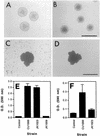Detachment of Actinobacillus actinomycetemcomitans biofilm cells by an endogenous beta-hexosaminidase activity
- PMID: 12896987
- PMCID: PMC166467
- DOI: 10.1128/JB.185.16.4693-4698.2003
Detachment of Actinobacillus actinomycetemcomitans biofilm cells by an endogenous beta-hexosaminidase activity
Abstract
When cultured in broth, fresh clinical isolates of the gram-negative periodontal pathogen Actinobacillus actinomycetemcomitans form tenaciously adherent biofilm colonies on surfaces such as plastic and glass. These biofilm colonies release adherent cells into the medium, and the released cells can attach to the surface of the culture vessel and form new colonies, enabling the biofilm to spread. We mutagenized A. actinomycetemcomitans clinical strain CU1000 with transposon IS903phikan and isolated a transposon insertion mutant that formed biofilm colonies which were tightly adherent to surfaces but which lacked the ability to release cells into the medium and disperse. The transposon insertion in the mutant strain mapped to a gene, designated dspB, that was predicted to encode a secreted protein homologous to the catalytic domain of the family 20 glycosyl hydrolases. A plasmid carrying a wild-type dspB gene restored the ability of biofilm colonies of the mutant strain to disperse. We expressed A. actinomycetemcomitans DspB protein engineered to contain a hexahistidine metal-binding site at its C terminus in Escherichia coli and purified the protein by using Ni affinity chromatography. Substrate specificity studies performed with monosaccharides labeled with 4-nitrophenyl groups showed that DspB hydrolyzed the 1-->4 glycosidic bond of beta-substituted N-acetylglucosamine, which is consistent with the known functions of other family 20 glycosyl hydrolases. When added to culture medium, purified DspB protein, but not heat-inactivated DspB, restored the ability of the mutant strain to release cells and disperse. DspB protein also caused the detachment of cells from preformed biofilm colonies of strain CU1000 grown attached to plastic and the disaggregation of highly autoaggregated clumps of CU1000 cells in solution. We concluded that dspB encodes a soluble beta-N-acetylglucosaminidase that causes detachment and dispersion of A. actinomycetemcomitans biofilm cells.
Figures





Similar articles
-
Biofilm growth and detachment of Actinobacillus actinomycetemcomitans.J Bacteriol. 2003 Feb;185(4):1399-404. doi: 10.1128/JB.185.4.1399-1404.2003. J Bacteriol. 2003. PMID: 12562811 Free PMC article.
-
Genes involved in the synthesis and degradation of matrix polysaccharide in Actinobacillus actinomycetemcomitans and Actinobacillus pleuropneumoniae biofilms.J Bacteriol. 2004 Dec;186(24):8213-20. doi: 10.1128/JB.186.24.8213-8220.2004. J Bacteriol. 2004. PMID: 15576769 Free PMC article.
-
Autoinducer 2 is required for biofilm growth of Aggregatibacter (Actinobacillus) actinomycetemcomitans.Infect Immun. 2007 Sep;75(9):4211-8. doi: 10.1128/IAI.00402-07. Epub 2007 Jun 25. Infect Immun. 2007. PMID: 17591788 Free PMC article.
-
Genes for tight adherence of Actinobacillus actinomycetemcomitans: from plaque to plague to pond scum.Trends Microbiol. 2001 Sep;9(9):429-37. doi: 10.1016/s0966-842x(01)02161-8. Trends Microbiol. 2001. PMID: 11553455 Review.
-
Aggregatibacter actinomycetemcomitans Dispersin B: The Quintessential Antibiofilm Enzyme.Pathogens. 2024 Aug 7;13(8):668. doi: 10.3390/pathogens13080668. Pathogens. 2024. PMID: 39204268 Free PMC article. Review.
Cited by
-
Elucidating the crucial role of poly N-acetylglucosamine from Staphylococcus aureus in cellular adhesion and pathogenesis.PLoS One. 2015 Apr 15;10(4):e0124216. doi: 10.1371/journal.pone.0124216. eCollection 2015. PLoS One. 2015. PMID: 25876106 Free PMC article.
-
Exopolysaccharide biosynthetic glycoside hydrolases can be utilized to disrupt and prevent Pseudomonas aeruginosa biofilms.Sci Adv. 2016 May 20;2(5):e1501632. doi: 10.1126/sciadv.1501632. eCollection 2016 May. Sci Adv. 2016. PMID: 27386527 Free PMC article.
-
Natural Strategies as Potential Weapons against Bacterial Biofilms.Life (Basel). 2022 Oct 17;12(10):1618. doi: 10.3390/life12101618. Life (Basel). 2022. PMID: 36295053 Free PMC article. Review.
-
Activated Polyhydroxyalkanoate Meshes Prevent Bacterial Adhesion and Biofilm Development in Regenerative Medicine Applications.Front Bioeng Biotechnol. 2020 May 15;8:442. doi: 10.3389/fbioe.2020.00442. eCollection 2020. Front Bioeng Biotechnol. 2020. PMID: 32671021 Free PMC article.
-
Recent advances on the regulation of bacterial biofilm formation by herbal medicines.Front Microbiol. 2022 Nov 8;13:1039297. doi: 10.3389/fmicb.2022.1039297. eCollection 2022. Front Microbiol. 2022. PMID: 36425031 Free PMC article. Review.
References
-
- Dubendorff, J. W., and F. W. Studier. 1991. Creation of a T7 autogene. Cloning and expression of the gene for bacteriophage T7 RNA polymerase under control of its cognate promoter. J. Mol. Biol. 219:61-68. - PubMed
-
- Fine, D. H., D. Furgang, and M. L. Barnett. 2001. Comparative antimicrobial activities of antiseptic mouthrinses against isogenic planktonic and biofilm forms of Actinobacillus actinomycetemcomitans. J. Clin. Periodontol. 28:697-700. - PubMed
-
- Fine, D. H., D. Furgang, J. B. Kaplan, J. Charlesworth, and D. H. Figurski. 1999. Tenacious adhesion of Actinobacillus actinomycetemcomitans strain CU1000 to salivary-coated hydroxyapatite. Arch. Oral Biol. 44:1063-1076. - PubMed
Publication types
MeSH terms
Substances
Associated data
- Actions
Grants and funding
LinkOut - more resources
Full Text Sources
Other Literature Sources

